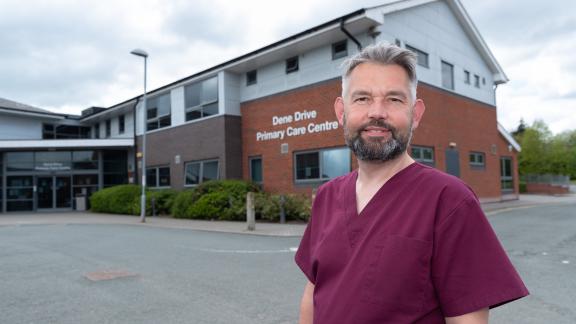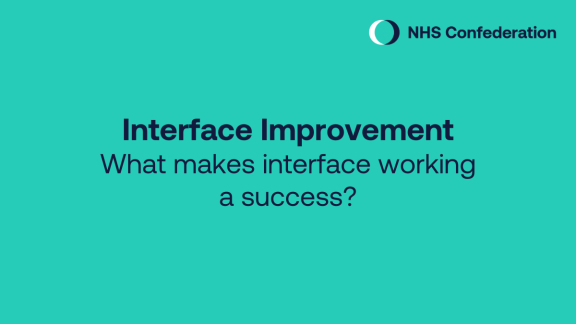
Advice, examples and recommendations from an interface improvement collaborative that has worked to address local challenges across the interface.
Introduction
From a patient safety and care perspective, we know that it’s important for primary and secondary (acute) sectors to work together to ensure a seamless patient care journey and help reduce duplication for patients. However, challenges to the patient journey exist at the transitional point, known as the interface, where patients move from primary to secondary care. If care providers are not collaborating effectively across this interface, errors can happen. Patients can ‘slip through the net’ or experience delays that impact their outcomes .
In 2024, we held an eight-month improvement collaborative in which teams of healthcare professionals from across the country came together to co-create innovative solutions to challenges they were facing locally around primary and secondary care interface working. The teams brought examples of problem areas they were experiencing, including advice and guidance, pre-operative care, referral optimisation and local pathway design.
A total of 11 teams took part (122 professionals), comprising various roles such as GPs, senior operational leaders, consultants, clinical and non-clinical directors, transformation leads, nurse leaders and data leads.
We worked with the dedicated cohorts of healthcare professionals to explore the problems, understand the data, test ideas, implement improvements and understand how to spread/sustain them. The teams then carried out work in their systems to improve interface working using tools, peer learning, resources and knowledge they gained from the programme.
Based on these teams’ experience, evaluation and feedback, this resource outlines what organisations can do to enable successful improvements to patient care across the interface and support cross-system working.
Understanding the problem
“It’s easy to jump straight to solution finding. We started with the assumption that we all had the same aim and were looking to 'fix' the same problem. However, it took some time for us to understand each other’s perspective and agree collectively on what problem to look at trying to 'fix'. I think the time taken to get to that point was invaluable in itself.”
Project teams need time to establish an agreed understanding of the problem area. This can help ensure the aim of the project and the intentions of what they are trying to achieve are aligned, it helps reduces ambiguity and ensures no critical information is missed.
When a project team is made up of professionals across the interface, creating a shared aim and goal requires an understanding of different roles, pressures and priorities for each person and their wider teams.
Building in time to dig deep into problems, assumptions, experiences and perspectives can help ensure the right direction of travel is taken in improvement work and reduce the risk of having to start again.
When designing an interface improvement collaborative locally, defining the problem is a critical step that is often missed or skimmed over but needs in-depth exploration through different tools and investigations. Some examples of these are gathering feedback from others (interviews, focus groups and surveys), carrying out observations, process mapping all the steps in a pathway or reviewing data to understand the problem.
Building relationships
“Getting stakeholders engaged and 'on side' takes a lot of time and work.”
Relationships and improvement go hand in hand. Having time to build relationships, trust and understanding across the interface is vital to help steer improvement work. There can be a sense of urgency to rush to improvement ideas and ‘do something’. Allowing additional time to understand people and differing styles of working among team members can help ensure long-term and inclusive commitment and cohesion as a team. Shadowing each other, having an informal after-work gathering, creating joint spaces and sharing stories are some examples used by teams.
Agreeing roles within the team, understanding the level of commitment, individuals’ strengths and creating interdependency can help sustain a shared purpose. The need for this increases when working with colleagues across the interface who are not part of your organisation.
Mapping of key stakeholders is essential to understand who influences, supports or blocks projects. Building early buy-in can reduce resistance. Mapping out all the people who are a touch point in the problem area as well as people who connect, support or influence it from a distance, can help build a comprehensive picture of how relationships need to be managed.
Communication and connection
“Our buddy team was a trusted sounding board – refreshing! We can be honest with them and the learning is much stronger when we get to know each other over time.”
Offering a blended approach to communication through virtual sessions, face-to-face meetings, written material/resources to refer to and recorded content allows team members the best opportunity to fully participate in improvement collaboratives.
Ensure a diverse range of experts deliver the content/programme that links to key steps in carrying out improvement provides rich insight, depth and learning.
Providing a point of contact who is there through the whole programme to help build an understanding of support needed, progress made and insight into what is needed to help drive improvement, ensures teams have dedicated improvement support and coaching.
A buddy scheme with teams working on similar problem areas in other systems can provide long-term mutual support, motivation and continuity of shared learning over time. This allows professionals across the country to connect, build trust, share experiences and learn from each other.
Leadership and culture
“The system culture needs to focus more on encouraging/enabling/resourcing structured improvement programmes.”
Leadership and culture are more complex in interface work as they span across boundaries. Leadership and culture at an organisational, team and individual level can hinder or help progress improvement work. In the design and delivery of improvement collaboratives, time, space and tools need to be factored in to understand how people behave, interact and sustain changes. This can be done through teams exploring different types of leadership styles they have, supporting them to understand what they need to create psychological safety and exploring the culture they work in through models such as Schein’s culture model, which helps dig deeper into how culture operates.
Organisations across the interface need a shared strategy for leadership in interface improvement. Without this, different professionals can struggle to work together and work effectively. For projects, this can be done through co-creating a shared purpose, understanding each organisation’s values and how they can come together. Frameworks such as Lencioni’s five dysfunctions (pyramid model) can be used for teams to assess how dysfunctional they are and what actions they can do to improve this, such as team building, ground rules, peer review or shared metrics.
Organisations can have reactive demands and shifting priorities that can slow projects down, leading to project meetings being cancelled and a weakening of commitment. Creating a culture that prioritises and protects improvement work can help empower and support teams to deliver results. This requires commitment from senior leaders to support the projects and protect them from the reactive demands. Embedding improvement work into normal working patterns helps make it part of core business and communicating progress and successes widely demonstrates it is valued.
Investment
“I think we find it hard to dedicate enough time to improvement activities to do them in a structured way…we hadn’t got dedicated, ringfenced time to do this.”
- Many projects across the interface require financial investment to help develop and sustain them. This can be challenging to secure and maintain when there are financial constraints, which can lead to stifling improvement projects. Working with colleagues outside the improvement team, such as business management and finance, to understand funding options, how to ‘make a case’ and how to influence commissioners, can help address this. Typically, improvement collaboratives do not focus on this and it is something to consider including in them to help think about sustainability from the start.
- Ensuring key stakeholders, who are enablers for financial investment, are aware and committed to improvement projects takes time and effort. Being able to develop a business case for financial investment alongside improvement methods can help secure funding.
- Other investment in the form of staff time and capacity to engage in improvement work, is needed to maintain pace and progress of improvement projects. Goodwill and working outside of work hours to support improvement is not sustainable. This can be done through providing dedicated programmed activity in job plans, time built in the shift patterns or written agreements on time allocation for improvement.
Internal governance
“The limitations we have had are specifically around internal governance, policy and procedures to move forward.”
- Governance varies between organisations. Differing policies, procedures and sign-off processes can delay the progress of improvement projects. Improvement projects cannot move at pace and scale if there are several layers of approval and competing governance that needs to be managed. Although this is a significant challenge, project teams can address some of this through creating joint governance charters that outline agreements across organisations on decision-making, accountability and responsibilities.
- Internal governance and project reporting can vary across organisations. Some organisations value scrutiny, reporting and performance monitoring rather than improvement. There needs to be the right balance between improvement and assurance and, alongside this, the reporting/documentation process should not be burdensome.
Data
"...data is helpful to provide evidence that a problem exists, and it isn't just a feeling.”
- The ability for organisations to share data across the interface can be a barrier to improvement and collaborative working. Various IT systems do not communicate, which can lead to delays and being unable to evidence improvement. Liaising and including business intelligence colleagues early on in projects can help create a better understanding of options available. Data-sharing agreements or anonymised aggregated data can be explored.
- Measurement/data is a key step in improvement, without it, improvement projects risk creating changes that have no impact. Working together as a team to understand what metrics to collect, how to access and review them needs to be worked through in a measurement plan. Including data analytics and business intelligence in these discussions can help determine what is viable.
- There can be a sense of survey and self-assessment fatigue in healthcare, with multiple requests as a baseline/improvement monitoring metric. While useful for helping understand issues, experiences and suggestions, there are limitations to using these methods as measures as they provide a fixed snapshot at a moment in time. Working across the interface to map existing resources and discussing them with the right people can help determine the right approach for data collection
Methodology
“… we need more dedicated improvement/transformation people in our part of the NHS to coordinate these more structured approaches to delivering quality improvement.”
- Organisations can have varying recommended approaches to improvement. This can be challenging when teams across the interface come together to collaborate on improvement and their approaches do not align. To help overcome this, improvement collaboratives should agree on the basic improvement steps that are needed but remain open to the range of approaches that can be taken to achieve them.
- Capability can vary amongst teams and organisations. This variability can impact progress and confidence in being able to deliver improvements. Structured support from central improvement teams is vital to bring all components together and provide a joined-up approach.
- Not all projects work at the same pace and moving through improvement methodology steps can be challenging when teams are at different stages. Improvement collaboratives need to be flexible and adaptable to prevent teams becoming reactive or disengaged. Ensuring the right pace can help teams that might be at different stages, learning material and templates/tools describing each step in the journey should be provided to teams.
Patient engagement
“We have run five patient groups to help steer the plans around our project area.”
- Authentic and inclusive patient engagement in improvement projects requires organisational enablement and processes to support this in practice. This can vary among organisations, which can lead to projects missing key stakeholder input. Seeking advice from patient experience teams and colleagues who already run patient engagement groups can help overcome some of these challenges.
- Supporting factors such as training staff on how to include patients in co-designing improvement work, financial numeration processes for patient time, and understanding different methods of patient engagement, can help ensure improvement projects are patient centred.
Recommendations
Carrying out improvement across the interface is challenging due to fragmented systems, different cultures, competing demands/priorities and unclear accountability. While some of these challenges require whole-system/organisational input, the feedback, experience and evidence from the teams involved in the interface improvement collaboratives have helped identify some key actions that leaders or improvement experts can take to support other interface improvement collaboratives:
Invest time in defining the problem together.
Don’t rush into solutions. Start by creating a shared understanding of the problem from multiple perspectives. Use tools like process mapping, stakeholder interviews and data reviews to explore assumptions and align on what needs to change. This alignment builds mutual respect and reduces misunderstandings down the line.
Prioritise relationship-building across boundaries.
Create time to understand people and different styles of working to help ensure long-term commitment and cohesion as a team. This can be done through shadowing, observations, having informal after-work gatherings, creating joint spaces and sharing stories. Clearly defined roles and responsibilities through a team charter can also support a shared purpose and accountability.
Blend communication channels to foster connection.
Offer multiple formats for team communication such as virtual meetings, in-person sessions, written resources and recorded content. Assign consistent points of contact and build peer connections across systems, such as buddy schemes, to enhance honesty, openness and learning.
Make improvement projects a priority.
Improvement work requires more than goodwill. Consistency is critical to maintain momentum and move at pace. Senior commitment can help prevent meetings/projects being cancelled due to organisational pressures and priorities. Offer protected time to staff, schedule meetings well in advance, create project meetings that add value, have clear actions and psychologically safe spaces.
Use experts to support enablement of improvement projects.
Seeking support for challenges such as data availability, financial investment or patient engagement requires central function support from colleagues such as business intelligence, finance managers and patient experience team. While they might not be core members of a project team, forming early connections and keeping in touch with them throughout the project can help provide answers and support to challenges faced.
Create a balance between improvement and assurance.
Governance differs across organisations. Seeking early clarity and advice from governance colleagues, commissioners and managers can help create an understanding of what is needed to align across organisations. Any documentation for improvement or assurance of projects must be clear, simple, add value to progressing the project and not be burdensome. Mapping out all the requirements and documentation needed along the way can help evidence and demonstrate the need to reduce it.
Examples from local collaboratives
Examples of successful interface working from teams that took part in the interface improvement programme.
Find out more about the primary and secondary care interface improvement programme:



